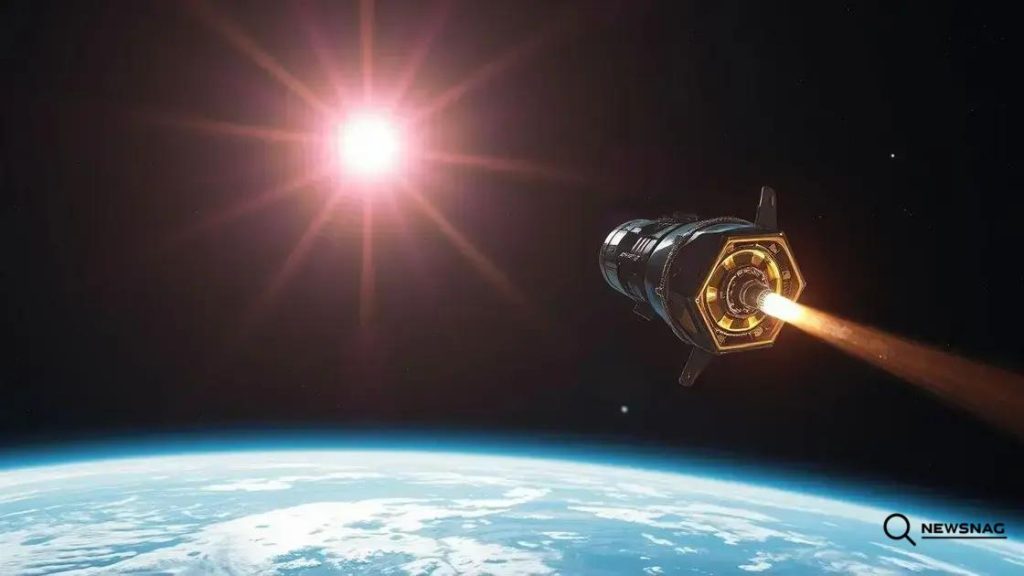Space tourism: the next frontier in commercial travel

Anúncios
Space tourism is the commercial activity of sending private individuals into space, driven by companies like SpaceX, Blue Origin, and Virgin Galactic, offering unique experiences while addressing safety, technology, and sustainability challenges.
Space tourism is quickly evolving into a thrilling opportunity for adventure seekers. Imagine floating among the stars, experiencing a new dimension of travel that once seemed impossible. Are you ready to explore this fascinating frontier?
Anúncios
An overview of space tourism
Space tourism has transformed from a dream to a possible adventure in our lifetime. With advancements in technology and growing interest, more people can aspire to travel beyond Earth’s atmosphere. This new frontier not only excites thrill-seekers but also poses fascinating opportunities for scientific research.
What is Space Tourism?
Space tourism refers to the commercial activity of sending private individuals into space for recreational, leisure, or adventure purposes. It includes various forms of travel, including suborbital flights, orbital spaceflights, and even future stays in space hotels.
Types of Space Tourism
- Suborbital flights: Experience a few minutes of weightlessness.
- Orbital flights: Spend several days aboard a space station.
- Space hotels: Future developments aim to build habitats in orbit for tourists.
This evolving sector has seen investments from private companies like SpaceX, Blue Origin, and Virgin Galactic. Each of these companies offers different experiences and price points, contributing to the growing accessibility of space travel.
Anúncios
The Experience
For those interested in taking the plunge, the experience can include unique views of our planet, thrilling sensations of launch, and the incredible feeling of floating in space. These aspects attract adventure enthusiasts and those looking for an unforgettable experience.
While the concept is exciting, potential travelers should keep in mind concerns about safety and costs. Prices can reach hundreds of thousands of dollars, which may deter many. Yet, as technology advances and more players enter the market, prices are expected to eventually decrease.
Future of Space Tourism
The future looks bright for space tourism. With continued advancements in spacecraft and the success of current missions, we may soon see an era where space travel is as commonplace as a plane flight. Innovations such as reusable rockets further enhance sustainability in this emerging market.
Key players in the space tourism industry
The space tourism industry is rapidly growing, driven by a few major players making headlines in this exciting new market. Companies like SpaceX, Blue Origin, and Virgin Galactic are pioneering efforts to make space travel accessible to civilians.
SpaceX
Founded by Elon Musk, SpaceX aims to reduce space travel costs through innovative technologies. Their reusable rocket system is a game changer, allowing for multiple launches from the same hardware. With missions like the Crew Dragon flights, they are proving their capability in transporting astronauts and civilians alike.
Blue Origin
Founded by Jeff Bezos, Blue Origin focuses on suborbital flights for space tourism. Their New Shepard rocket offers short but thrilling experiences of weightlessness. Passengers can enjoy a few minutes of floating in space while witnessing breathtaking views of Earth.
Virgin Galactic
Virgin Galactic, started by Sir Richard Branson, seeks to provide suborbital flights with a unique spaceplane design. With their SpaceShipTwo, they plan to offer tourists a chance to experience space for a premium price. The focus is on creating a comfortable and exhilarating journey for travelers.
In addition to these well-known firms, numerous startups are entering the market. Companies like Axiom Space and Space Adventures are working on space stations and orbital tourism experiences. These innovations indicate that the industry is expanding, and competition will likely lead to more options for future travelers.
Conclusion
As new players emerge in the space tourism arena, the excitement around space travel continues to grow. This industry’s future depends on the successes and innovations of these key players, making it a thrilling time for potential tourists.
The technology behind space travel

The technology behind space travel is fascinating and complex, involving multiple fields of engineering and science. Innovations have made it possible to send humans and equipment beyond our planet’s atmosphere, paving the way for space tourism.
Rocket Propulsion
The heart of any space mission is rocket propulsion. Rockets use powerful engines to produce thrust, propelling them into the sky. There are two main types of propulsion systems: liquid fuel and solid fuel. Each has its advantages, but the goal remains the same: to break free from Earth’s gravity.
Reusability
One of the most exciting advancements in recent years is the reusability of rocket components. Companies like SpaceX have developed reusable boosters that can land back on Earth after launching a payload. This not only reduces costs but also makes space travel more sustainable.
Navigation and Guidance Systems
Accurate navigation is crucial for any space mission. Modern spacecraft use satellite-based systems combined with advanced software to provide precise positioning and direction. This technology ensures that rockets can reach their intended destinations safely.
Life Support Systems
When people travel to space, they need to survive in a harsh environment. Life support systems provide essential functions like oxygen supply, temperature control, and waste recycling. These technologies ensure astronauts can live safely in space for extended periods.
Moreover, advancements in communication technology enable astronauts to stay in contact with mission control and loved ones back home. This makes the experience more reassuring and connected. As more companies invest in developing industry standards, the future of space tourism becomes even more promising.
Future Technologies
The future of space travel will likely include even more innovative technologies like advanced propulsion systems such as ion propulsion and nuclear thermal engines. These could significantly shorten travel time to distant destinations, making space travel more feasible for tourists.
Safety measures in space tourism
When it comes to space tourism, safety is a top priority. Traveling to space involves unique risks, and companies must implement robust safety measures to protect passengers. Various protocols and technologies ensure that tourists can enjoy their journey safely.
Pre-Flight Training
Before embarking on their journey, passengers typically undergo thorough training. This training helps tourists understand what to expect during the flight. They learn about weightlessness, emergency procedures, and safety equipment. This preparation is crucial for ensuring a smooth experience.
Quality Control and Testing
All spacecraft undergo rigorous testing before they are deemed safe for human flight. Companies like SpaceX and Blue Origin conduct extensive quality control checks on every component of their rockets. This includes simulations and test flights to identify any potential failures.
Safety Equipment
In case of emergencies, each spacecraft is equipped with essential safety gear, including:
- Oxygen masks to ensure breathable air.
- Emergency parachutes for safe landings.
- Life support systems to maintain a stable environment.
These features are designed to keep passengers safe throughout their journey. Continuous monitoring systems track the craft’s conditions and alert crews to any issues.
Another vital aspect is the development of escape systems. These systems allow for quick separation from the rocket in case of a launch failure, ensuring passengers have the best possible chance for survival. As technology advances, these safety measures will continue to evolve.
Post-Flight Health Monitoring
After returning to Earth, astronauts and tourists often undergo health evaluations. This monitoring helps identify any physical effects from their journey, such as changes in vision or balance, ensuring that all passengers return safely and a healthier way.
Future trends and potential challenges
The future of space tourism is bright but also comes with challenges that need to be addressed. As technology advances and interest grows, more people will want to experience journeys beyond our planet.
Emerging Technologies
One significant trend is the development of new technologies that can enhance the space travel experience. Companies are working on faster and more efficient spacecraft, which could shorten travel times significantly. This means that destinations like Mars might soon be accessible to tourists.
Sustainable Practices
As the industry grows, there’s an increasing focus on sustainability. It’s essential for companies to develop environmentally friendly practices, like using reusable rockets. Innovations in propulsion systems will also play a crucial role in minimizing the ecological footprint of space travel.
Market Expansion
The space tourism market is becoming more competitive. This increased competition can lead to better prices and more options for potential travelers. As more companies enter the industry, a wider variety of experiences will be offered, allowing for significant growth in the market.
Challenges Ahead
Despite the excitement, challenges remain. Safety is always a top concern, and companies must continuously improve their safety measures. Concerns about the mental and physical effects of space travel on tourists are also important. Research in these areas will be crucial to ensuring a safe experience.
Regulatory Issues
As space tourism continues to expand, regulatory frameworks will need to develop. Governments must create clear guidelines for flight operations and safety standards. This is essential to protect both tourists and the growing industry itself.
In conclusion, while the future trends of space tourism are filled with potential, addressing these challenges will be vital in shaping a successful and sustainable environment for future travelers.
FAQ – Frequently Asked Questions about Space Tourism
What is space tourism?
Space tourism refers to commercial activities that send private individuals into space for recreational and leisure purposes, allowing civilians to experience space travel.
What are the major companies involved in space tourism?
Key players include SpaceX, Blue Origin, and Virgin Galactic, each offering unique space travel experiences.
What safety measures are in place for space tourists?
Safety measures include pre-flight training, extensive vehicle testing, and onboard safety equipment to ensure passenger security during the flight.
What future trends can we expect in space tourism?
Future trends include advancements in technology, more sustainable practices, and increased market competition, which will provide more choices for space travelers.





